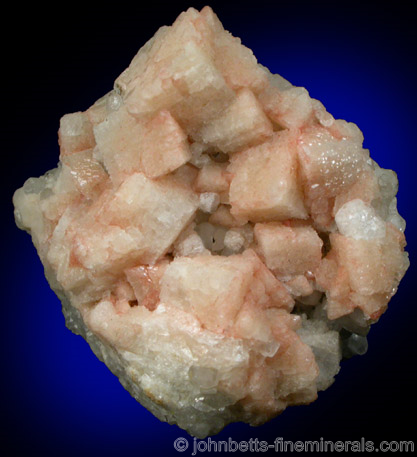The Mineral gmelinite

Since its original classification, Gmelinite was always regarded as a
single mineral species with a variable elemental makeup. In 1997,
the Zeolite Subcommittee of the IMA divided this mineral into
individual sub-species, thereby regarding Gmelinite as a series of three members. The series is defined by the presence of several variable
elements in the following order: calcium, sodium, and potassium. Calcium-dominating Gmelinite is called Gmelinite-Ca, and
is the most prevalent form of this series. Sodium-dominating Gmelinite, defined as Gmelinite-Na, and potassium-dominating Gmelinite, defined as Gmelinite-K, are both rare. Most Gmelinite specimens in
collections are Gmelinite-Ca. A distinction among the different Gmelinite types is rarely made, and the members are generally just
termed Gmelinite without further breakdown.
Gmelinite is very
similar in structure and habit to the closely related Chabazite, though it can be distinguished by its more reflective luster and triangular crystal angles.
Gmelinite often forms as a pseudomorph after Chabazite, retaining
the original rhombic shape but forming modified faces.
Gmelinite was defined and named in 1825 by David Brewster in honor of Christian Gottlob Gmelin (1792-1860), a mineralogist and chemist at the University of Tübingen, Germany.
Chemical Formula
Gmelinite-Ca: (Ca,Na2)Al2Si4O12 · 6(H2O)
Gmelinite-Na: (Na2,Ca)Al2Si4O12 · 6(H2O)
Gmelinite-K: (K2,Na2,Ca,)Al2Si4O12 · 6(H2O)
Color
Orange, pink, red, light yellow, light brown, white, colorless
Properties
Streak
White |
Hardness
4.5 |
Transparency
Transparent to translucent |
Specific Gravity
2.0 - 2.1 |
Luster
Vitreous to adamantine |
Cleavage
2,1 |
Fracture
Uneven |
Tenacity
Brittle |
Crystal Habits
Forms as distinct dipyramidal hexagons with flattened heads, often in the shape of a disc or a characteristic flying saucer. Crystals usually have triangular angles or striations, and may be in a rhombohedral shape as pseudomorphs of Chabazite. Also in dense groups of crystals, in rounded hemispherical aggregates, grainy, and drusy.
Uses
Gmelinite is used as a collectors mineral, especially by zeolite collectors.
Noteworthy Localities
Gmelinite is an uncommon mineral, and although it found in microcrystals in many zeolite deposits, large and well-formed crystals only come from a handful of occurrences. Important European localities include Vicenza Province, Italy at Nero Mountain in Montecchio, and at Fara Vicentino. Well-formed crystals and rounded balls were found in the Little Deerpark Quarry, Glenarm, Co. Antrim, Northern Ireland. Large, peachy-orange clusters come from Sarbaiskoe, Kostanay Province, Kazakhstan; and well-formed crystals with good color from Flinders, Victoria, Australia.
In the U.S., some of the best Gmelinite crystals have come from Paterson and Prospect Park, Passaic Co., New Jersey, in tan and peach crystals and as pseudomorphs after Chabazite. Lustrous Gmelinite crystal were occasionally found at Laurel Hill (Snake Hill), Secaucus, Hudson Co., New Jersey; and white and colorless crystals were found in Devils Backbone, Grant Co., Oregon. In Canada, perhaps the finest examples of this mineral can be found in the Nova Scotia zeolite deposits. These include Pinnacle Rock, Five Islands; where very large and lustrous pseudomorph after Chabazite have been found, and Wasson's Bluff at Parrsboro.
Distingushing Similar Minerals
Chabazite - Different crystal formation (lacks triangular growths), and generally has a less intense luster.